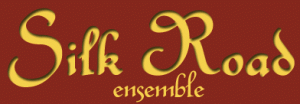A MUSICAL TRAVELOGUE
Silk Road Ensemble’s violinist Colin Jacobsen introduced his “Atashgah” to an attentive crowd at the gorgeous Valley Performing Arts Center with a simple, “I wrote this piece.” Yet magically, it didn’t appear written at all. The consistent soul-searching and yearning that emanated from the 11-piece ensemble rendered the  work seemingly improvisational. The adventurous composition is an introspective reflection on ancient temples Jacobsen visited in Iran, and exemplified the program last Tuesday, a celebration of the 15th anniversary of Silk Road, formed under the artistic direction of cellist Yo-Yo Ma. Filled with enthralling energy, rich Middle Eastern harmonies, and ever-changing rhythms, time signatures and meters, their sound is a fusion of contemporary, classical, chamber and world music.
work seemingly improvisational. The adventurous composition is an introspective reflection on ancient temples Jacobsen visited in Iran, and exemplified the program last Tuesday, a celebration of the 15th anniversary of Silk Road, formed under the artistic direction of cellist Yo-Yo Ma. Filled with enthralling energy, rich Middle Eastern harmonies, and ever-changing rhythms, time signatures and meters, their sound is a fusion of contemporary, classical, chamber and world music.
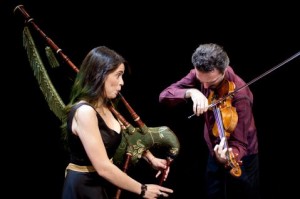 Certainly there were moments of improvisation as players were giving and taking democratically in the same way as flamenco artists. But it was a completely improvised set performed by Sandeep Das and Kayhan Kalhor that validated these players as world-class musicians. They performed a “Jugalbandi,” which is a performance in Indian classical music that features two musicians (the name is translated as “two together” but literally means “combined twins”). We were fortunate to see them as it is rare that a jugalbandi has musicians from different cultures – but this is the Silk Road Ensemble’s mission: To draw together distinguished performers and composers from more than 20 countries in Asia, Europe and the Americas who explore contemporary musical crossroads.
Certainly there were moments of improvisation as players were giving and taking democratically in the same way as flamenco artists. But it was a completely improvised set performed by Sandeep Das and Kayhan Kalhor that validated these players as world-class musicians. They performed a “Jugalbandi,” which is a performance in Indian classical music that features two musicians (the name is translated as “two together” but literally means “combined twins”). We were fortunate to see them as it is rare that a jugalbandi has musicians from different cultures – but this is the Silk Road Ensemble’s mission: To draw together distinguished performers and composers from more than 20 countries in Asia, Europe and the Americas who explore contemporary musical crossroads.
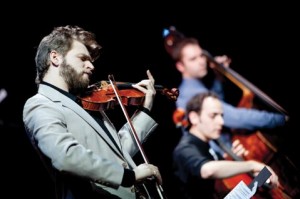 The intersection in this case is Indian (Das) and Persian (Kalhor). So it was not just a playful competition among players but a conversation between two cultures. Kalhor played the kamancheh, a Persian bowed string instrument that sits on a spike and is played like a cello (it’s also known as spiked fiddle). He created an exquisite mix of mournfulness and joy by sawing and arcing with his bow, then hypnotized as he plucked with dexterous fingering. Das played the tabla, a pair of hand drums of contrasting sizes and timbres with a range of colors astounding to behold: I heard popcorn, water over stones, bongos, thumps, flap-flap-flaps, flutters and even clicks. This showcase also made apparent that these two are great friends.
The intersection in this case is Indian (Das) and Persian (Kalhor). So it was not just a playful competition among players but a conversation between two cultures. Kalhor played the kamancheh, a Persian bowed string instrument that sits on a spike and is played like a cello (it’s also known as spiked fiddle). He created an exquisite mix of mournfulness and joy by sawing and arcing with his bow, then hypnotized as he plucked with dexterous fingering. Das played the tabla, a pair of hand drums of contrasting sizes and timbres with a range of colors astounding to behold: I heard popcorn, water over stones, bongos, thumps, flap-flap-flaps, flutters and even clicks. This showcase also made apparent that these two are great friends.
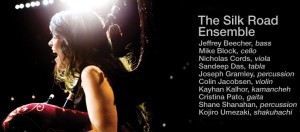 The Silk Road Suite in three parts introduced us to the varied artists. “Caronte,” composed by Cristina Pato, showed off her mind-numbing skill on the gaita, a bagpipe common to northern Spain. Percussionist Shane Shanahan, who rocks on the bass marimba among other instruments, wrote “Saidi Swing,” a Middle Eastern Percussion Quartet which uses the four-beat rhythmic figure common in traditional Egyptian dance but swings out into unchartered territories, highlighting the chameleonic work of founding member and percussionist Joseph Gramley, who almost looks like a 1950s history professor in suit and tie, but whose soul reaches out across the ages. It was a marvel to see how accomplished he is with so many instruments, adroitly interchanging sticks, mallets, brushes and gourds in just a few minutes.
The Silk Road Suite in three parts introduced us to the varied artists. “Caronte,” composed by Cristina Pato, showed off her mind-numbing skill on the gaita, a bagpipe common to northern Spain. Percussionist Shane Shanahan, who rocks on the bass marimba among other instruments, wrote “Saidi Swing,” a Middle Eastern Percussion Quartet which uses the four-beat rhythmic figure common in traditional Egyptian dance but swings out into unchartered territories, highlighting the chameleonic work of founding member and percussionist Joseph Gramley, who almost looks like a 1950s history professor in suit and tie, but whose soul reaches out across the ages. It was a marvel to see how accomplished he is with so many instruments, adroitly interchanging sticks, mallets, brushes and gourds in just a few minutes.
Finishing up the suite, Lebanese expatriate Rabih Abou-Khalil’s “Arabian Waltz” sounded like a mystical festive wedding party in an oasis, but with a classical bent, showing off the miraculous strings: Jacobsen (violin), Johnny Gandelsman (violin), Nicholas Cords (viola), Jeffrey Beecher (bass), and Mike Block (I have never before seen a standing cello player – incredible).
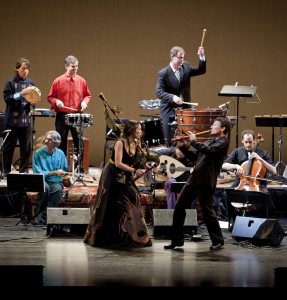 Other pieces amalgamating East and West included a suite of four John Zorn tunes from his Book of Angels arranged with jazzy cadences and agitated spirituality by individual Silk Road musicians; and “Celtibera,” by Block and Pato, who played the Isle of Arran folk song with gripping Celtic-like rhythms.
Other pieces amalgamating East and West included a suite of four John Zorn tunes from his Book of Angels arranged with jazzy cadences and agitated spirituality by individual Silk Road musicians; and “Celtibera,” by Block and Pato, who played the Isle of Arran folk song with gripping Celtic-like rhythms.
My personal favorite was Chinese-American composer Angel Lam’s Empty Mountain Spirit Rain. As accomplished as the musicians are, there tends to be a similarity in sound during the program. While much of the music had a festive quality, this piece clearly had a narrative, exemplified by a tranquility that gave voice to the players individually. The heartfelt interplay of Gandelsman and Block was exquisite and clarified the mournful aspects of the story of a little girl who loses her Grandmother. Kojiro Umezaki, who elegantly and eloquently introduced the work, plays the shakuhachi, a Japanese end-blown flute made of bamboo. Umezaki brought a plaintive joy with controlled phrasing, often finishing a line by snapping up on a note; he truly embodied a sound both physical and spiritual.
This is the Ensemble’s seventh concert tour of the North American West Coast, playing through Nov. 1, 2013, but I can’t imagine a finer venue with better acoustics than the ritzy Valley Performing Arts Center on the CSUN campus. I felt as if I had traveled around the globe without ever leaving my seat.
photos of previous concerts by Max Whittaker, courtesy of Silk Road Ensemble
The Silk Road Ensemble
North American West Coast Concert Tour
Valley Performing Arts Center in Northridge
played on October 22, 2013
for future VPAC shows, call (818) 677-3000
or visit www.valleyperformingartscenter.org
for tour info and dates, visit www.silkroadproject.org

